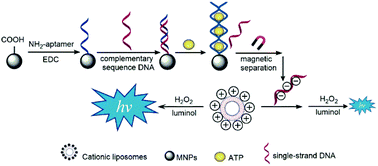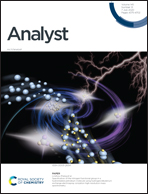Cationic liposome-triggered luminol chemiluminescence reaction and its applications†
Abstract
Liposomes are spherical phospholipid bilayer vesicles. In the present study, we found that cationic liposomes made by (2,3-dioleoyloxy-propyl)-trimethylammonium (DOTAP) could enhance the luminol-H2O2 chemiluminescence (CL) reaction. Mechanism studies showed that the positive charge on the surface of liposomes plays an important role in the CL process. We speculated that the cationic liposomes with quaternary ammonium groups on the surface may be capable of catalyzing the decomposition of H2O2 leading to the formation of oxygen-related free radicals including ˙OH, 1O2, and O2˙−. The luminol anions tend to move close to the surface of the cationic liposomes and then to be oxidized by the oxidizing radical species which may be around the surface of cationic liposomes forming excited-state 3-aminophthalate* (3-APA*). When the 3-APA* returns to the ground state, an enhanced CL is observed. In addition, the single-strand DNA (ssDNA) showed a significant inhibition effect on the proposed CL reaction. The CL intensity decreased linearly with an increasing amount of DNA from 0.05 to 2 pmol. We assumed that the binding of ssDNA with cationic liposomes would neutralize the positive charge on the surface of liposomes and inhibit the catalytic activity of DOTAP cationic liposomes. Based on the ssDNA-inhibited luminol-H2O2-cationic liposome CL reaction, simple label-free CL sensing platforms were developed for the detection of sequence-specific DNA related to the hepatitis B virus (HBV) gene and for the detection of ATP (as a model analyte) using an anti-ATP aptamer as the recognition element.



 Please wait while we load your content...
Please wait while we load your content...